Ck2 Agot Make Dragons Appear Again
- This article is about the winged reptiles. For the special feature, see: Dragons
- "Dragons are intelligent, more intelligent than men according to some maesters. They have affection for their friends and fury for their enemies."
- ―Tyrion Lannister
Dragons are massive, flying reptiles that can breathe fire. They are rumored to have a strong connection to magic, which seems to be proven true when magic begins to return to the world after the birth of the first three in over two hundred years. Dragons possess awesome and devastating power, capable of laying waste to armies and burning entire cities to ashes. Men who were able to tame and ride dragons as beasts of war used them in battle and to forge vast empires across the continents of Essos and Westeros. The greatest of these empires was the Valyrian Freehold forged by the Valyrian dragonlords.
Aegon I Targaryen and his sisters used the last three surviving dragons in the world to conquer and unify the Seven Kingdoms of Westeros. For generations, the dragon-kings ruled over much of Westeros - but the dragons eventually died out after nearly a century and a half, and the species was subsequently considered to be extinct.
At the same time that the War of the Five Kings began in Westeros, Daenerys Targaryen was in possession of three petrified dragon eggs. They were given to her as a wedding gift, beautiful to look upon and valuable beyond comprehension, but otherwise useless. However, in a shocking display of old magic, Daenerys miraculously hatched the eggs and for the first time in generations, dragons filled the skies.
Biology
Overview
Dragons have long serpentine bodies, with proportionately long necks and tails. Their bodies have four limbs: two short back legs and two large wings as forelimbs, a body-plan similar to a bat. In later generations, after the dragons went extinct, physical descriptions of dragons became so confused in memory that artwork sometimes depicted them as having six limbs - two wings growing out of their backs in addition to four legs - but this is inaccurate, at least in Westerosian legend. The teeth and claws of adult dragons are as long and sharp as swords.
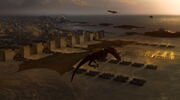
Daenerys marches forward with her army and her young dragons.
Dragons are covered in scales, as well as spines that run down their backs from head to tail. Particularly large ridges of horns frame the edges of their faces, running along the back of the skull and along the jawline, which grow bigger as they mature. Adult dragons possess two sets of frills that run along the backs of their necks and spine, two along the sides of their necks and another two centered closer to the backbone, for a total of four frills. These are formed from webbing that grows between longer spines. When dragons are agitated (or simply excited), they raise and flare these frills - similar to how a furry animal like a cat will raise the hackles on its back when agitated (or a feathered animal such as a goose will puff up its feathers), in an attempt to appear bigger so as to intimidate its enemies.
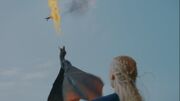
Dragons will roast their food before consumption.
Dragons are also shown to have a variety of calls, from shrieking roars to low growls or hisses. They can even squeal.
Dragons are obligate carnivores, with diets consisting entirely of meat. Dragons need to roast their prey with their fire-breath before consuming it - the only animals apart from humans who prefer cooked meat. Dragons can eat almost any kind of meat, anything from sheep to fish. Historical dragons ridden as beasts of war were known to eat fallen horses and even men on the battlefield. Fully grown dragons could swallow a live horse whole.
Color variations
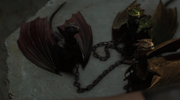
Dragons have different color patterns.
The scale color of dragons is highly variable, and historical dragons ranged in color from black to silver, red, gold, and even blue. Some dragons were one solid color throughout, but more often, they tend to have one primary color for most of their body, with highlights in a secondary color along their spinal crests, horns, and wing membranes. Confirmed markings observed so far include:
- Black with red markings
- Green with bronze markings
- Cream with gold markings
In addition to the various scales hues observed between specimens, dragons also displayed eye color variations. Dragons being reptiles, they had vertical slit pupils with large colored irises. Drogon and Rhaegal have red eyes while their brother, Viserion, had green eyes before becoming a Wight.
Fire-breath
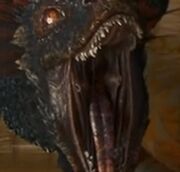
Small tubes in Drogon's mouth showing where they spit fire from.
Probably the most famous attribute of dragons is their ability to breathe fire. Dragon flame can turn flesh to ash, melt steel, and crack stone. Older dragons can produce a more intense flame for longer durations. The bodies of dragons are also very resistant to fire, particularly their own flames, which will not damage their own mouths as they expel them. Some believe that in many ways dragons are fire, fire given form as flesh: it is said that "fire cannot kill a dragon".
Dragons seem to produce their fire-breath by expelling chemicals out of two tubes either side of their mouths: when these volatile substances combine, they undergo an intense reaction which bursts into a directed jet of fire. Later in the series, this idea seemed to be abandoned. There are several shots where fire is seen emanating from the dragons' throats not out of the tubes in their mouths. During the Battle of Winterfell, flames leak from the neck of the undead Viserion after he suffers injuries from his brother Rhaegal.
Reproduction

A dragon egg being hatched.
Like most reptiles, dragons lay clutches of eggs. Dragon eggs are roughly the size of a human child's head, and as heavy as stone, so they need to be carried with two hands. The outer shell is covered in scales, with vastly different color patterns between eggs, usually matching the color of the dragon inside. Dragon eggs are notoriously difficult to hatch, though they can maintain the spark of life inside of them for decades if not centuries. The secret key to hatching the eggs seems to involve some form of blood magic: as the house words of the Targaryens hint, it requires "fire and blood". To hatch them, dragon eggs must be burned in roaring flames, with which another creature is simultaneously being burned alive - a life in exchange for a life. In the wild, this might just be a prey animal that the parent dragon kills, but human sacrifice will do the trick quite nicely, particularly if there is more than one egg to hatch.
The exact details of dragon reproduction fell out of living memory in the nearly two centuries since they died out. Several conflicting theories and rumors have been circulated, some less grounded in fact than others. It is unclear if the mother guarded eggs she had laid, or simply left them to hatch and fend for themselves, or if the father aided the mother in caring for them. Dragons were apparently relatively solitary creatures, though it is unknown if any hierarchical relationships formed within groups of dragons.
Dragons, like birds, tend to imprint on whoever is present when they hatch, regarding that person as their parent.
Maturation
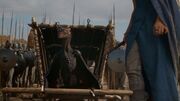
Drogon, the size of a small dog.
Newly hatched dragons are about the size of a small cat, but they grow very rapidly, reaching the size of a small dog in about one year, and the size of a small pony in only three or four years. The rate at which specific dragons can grow varies from one to the next, but in some cases dragons can grow big enough to ride after only a few years. It is unknown at what age dragons reach reproductive maturity. Dragons never stop growing as long as they live, and they can live for centuries, though many died in combat before reaching such an age. The largest Targaryen dragon, Balerion the Black Dread, lived for nearly two centuries and had a skull the size of a carriage.
However, if dragons are chained or confined into an enclosed space for long periods of time it can hinder their growth and their overall size. Rhaegal and Viserion who hatched at the same time than Drogon were considerably smaller than their sibling, around half his size after being locked under Meereen's great pyramid for almost two years at an early stage of their development.
When dragons hatch, they do have horns around their faces and along their spines, but they are still quite small and relatively rounded. Their horns grow increasingly longer and sharper as they mature, quickly making the dragon appear more dangerous and menacing to prey or other dragons. The four lines of webbed frills along a dragon's spine only grow to a prominent size after they are about a year old. The bigger the dragon is, the bigger its appetite.
When a dragon reaches adolescence, roughly when they are the size of a pony, they tend to be rebellious to a degree, much like how human teenagers are, even snarling at their imprinted parent. However, as they mature, this trait disappears.
Training and riding
Dragons cannot be truly "tamed", but they can be bonded with and trained. According to a semi-canon source, humble Valyrian shepherds were the first to control them using magic, and rode dragons for millennia. Aegon I Targaryen and his sister-wives, who descended from Old Valyria, used the last three dragons in the world to conquer and unify the Seven Kingdoms.
Dragons are fairly intelligent animals, and like a horse or a dog, they can be trained by their rider to respond to basic voice commands. Tyrion Lannister claims that dragons are intelligent, much more so than most people and will quickly recognize friend from foe. If they are not trained they will quickly lay waste to anything around them. The key to training dragons is making sure they are well-fed, a dragon with a full stomach is more obedient.
Since they cannot be truly tamed, dragons can be very dangerous even to their riders. However, they can form very strong bonds with their riders and will show affection and trust towards them. They will even nuzzle their riders, hoping to be petted.
Daenerys Targaryen has trained her three dragons to respond to vocal commands in her mother tongue of High Valyrian. She often uses the command "Dracarys", to which her dragons respond by instantly breathing fire and burning anything in their path.
History
Background
The first known dragons were mentioned to have their lairs in the Fourteen Fires, a chain of volcanoes across the neck of the Valyrian Peninsula. The Valyrians, then peaceful shepherds, tamed the dragons with magic, even learned how to master and ride them as beasts of war. Thus they began expanding their influence from the Peninsula to the rest of their continent forming the Valyrian Freehold. The dragons gave the decisive victory in the Ghiscari Wars during which the Old Ghis is burned to ashes by dragonfire, and the ever-expanding Freehold replaced the Ghiscari Empire as the dominant culture of Essos. The Rhoynar under Nymeria fled to Dorne having no chance against the Valyrian dragons.
Four hundred years before the War of the Five Kings, the entire Valyrian empire was destroyed in a single day, during a cataclysmic volcanic eruption known as the Doom of Valyria. Most dragons, still lairing in the volcanoes, were killed outright. One Valyrian noble family, the Targaryens, survived the Doom on the distant island outpost of Dragonstone in the Narrow Sea - along with the last surviving Valyrian dragons.
The last surviving dragons in the world were possessed by House Targaryen, the last Valyrians after the Cataclysm, who used them to conquer and unify the Seven Kingdoms of Westeros three hundred years before the War of the Five Kings. Most of the Targaryen dragons died in a civil war known as Dance of the Dragons about a century and a half later, and after that, the only dragons the Targaryens had were the size of cats. Soon after the civil war ended, the last Targaryen dragons died, and the species was considered to be extinct throughout the world.
Season 1
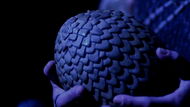
A dragon egg, used as an heirloom or item of value.
In the series, the dragon species is established as having been extinct for many years. The only thing left of the race are petrified dragon eggs, which are used as decoration, and the bones which are used for weapon crafting. According to one legend, dragons originated from a second moon that hatched when it drifted too close to the sun. This is mostly dismissed as a simple myth.
They remain the sigil of House Targaryen, who were known to have a special affinity with the creatures. Even Daenerys Targaryen who knows nothing of her true heritage feels a connection with the relics of the ancient animals. She appears to feel a connection with the eggs; causing her to develop a curiosity about the race and the possibility that there may still be living dragons.
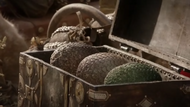
Daenerys's dragon eggs, gifted to her by Illyrio Mopatis.
Daenerys is given three petrified dragon eggs as a gift for her wedding to Khal Drogo. The three eggs are black, green, and gold.[1]
Daenerys begins caring for the eggs as they become richer in color. She keeps them in a chest surrounded by candles, day and night as she is drawn to them.[2]
Arya stumbles upon the massive skull of one of the Targaryen dragons while chasing a cat in the vaults. She hides in the mouth of the skull and overhears the plotting of Illyrio and Varys.[3]
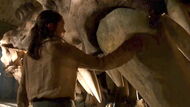
The skull of a dragon, kept in the vaults below the Red Keep of King's Landing.
Daenerys continues to experiment with her eggs. She briefly places one of the eggs into a fire pit in an attempt to hatch it, but the egg remains unhatched. She removes the egg from the fire with her bare hands, but remains unhurt.[4]
Daenerys Targaryen places the eggs on the funeral pyre of her husband after smothering him with a pillow. She also straps the witch Mirri Maz Duur to the pyre. She then lights the pyre, and walks into it, with all her followers believing her to have burned alive. In the morning, however, she is found with three dragons, a green dragon in her arms, a black dragon clinging on her shoulder and a white-peach colored dragon clinging on her leg. A moment later, the black dragon screeches and flaps his wings.[5]
Season 2
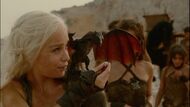
Daenerys tries to feed Drogon raw meat.
Daenerys tries unsuccessfully to feed her dragons raw meat, unsure of what she is doing wrong.[6] Later, in Qarth, she realizes that they will only eat cooked meat. She coaxes them into recognizing the Valyrian command, "Dracarys," to breathe fire, so they can cook their own food.[7]
During her stay in Qarth, word of the dragons' return begins to travel to other parts of Essos; the rumors are eventually picked up by Varys, who mentions them to Tyrion Lannister. Tyrion is more concerned with the impending Battle of the Blackwater than with newly hatched dragons on the other side of the world.[8]
The dragons are later stolen by the warlocks of Qarth and hidden in the House of the Undying.[9] The warlocks and Xaro Xhoan Daxos carry out a coup to seize control of the city in the wake of the theft. Pyat Pree invites Daenerys to come to the House of the Undying and be reunited with her 'babies'.[10]
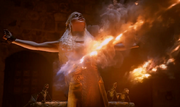
Dany's dragons breathe fire in "Valar Morghulis."
Once Daenerys is inside the citadel she is enthralled by two specific illusions: the Iron Throne room with a destroyed roof and snow falling in and the illusion of her dead husband and child. The sound of the crying dragons pulls Daenerys out of the temptation to stay in either illusion. Continuing her search for her dragons she finds them all chained beside each other, and they scream with excitement when she nears them. Daenerys goes to them, only to find herself chained as well. With her arms stretched to either side of her she becomes a captive. However with a bit of a twisted smile, Daenerys speaks the High Valyrian word for fire, and Drogon first answers her call, but isn't very effective by himself. However, both Rhaegal and Viserion then join in, setting Pyat Pree ablaze.[11]
Season 3
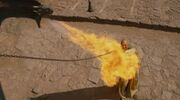
Drogon kills Kraznys.
Daenerys arrives with her dragons in Slaver's Bay, hoping to acquire an army of Unsullied. With nothing else to pay the slave-masters, she offers them her largest dragon, Drogon, in exchange for all eight thousand of their Unsullied soldiers.[12] However, the deal is a ruse; after slave master Kraznys mo Nakloz gives her the whip signifying ownership of the Unsullied army, the dragon remains loyal to her. Revealing to everyone that she speaks Valyrian fluently, she orders her new army to slay all of the slave-masters within the city. Daenerys then commands Drogon to attack Kraznys; the slave master is consumed in a powerful jet of Drogon's fire-breath. Drogon and the other dragons then provide air support for the Unsullied as they sack Astapor, burning more of the slave-masters and their personal guards. Afterwards, Daenerys's new army triumphantly leaves Astapor marching in formation, with her three dragons flying above.[13]
When Daenerys besieges Yunkai next, she keeps her three dragons in her tent when she receives the Yunkish ambassador Razdal mo Eraz, in order to intimidate him. At one point she casually throws a piece of meat to them and they playfully fight over it, much to Razdal's consternation. Daenerys ultimately rejects Razdal's offer to leave Yunkai alone in exchange for a gift of gold, but chooses to keep the gold anyway. When Razdal's slaves attempt to retrieve it the dragons scare them away. After Razdal threatens Daenerys the dragons grew more agitated; Daenerys points out that he had threatened their "mother", and while she had promised him safe passage as an ambassador, her dragons did not. Razdal leaves in frustration.[14]
Daenerys ultimately decides not to risk endangering her young dragons again by deploying them against Yunkai, but sends in an infiltration mission consisting of Daario Naharis, Jorah Mormont, and the Unsullied commander Grey Worm. After fighting their way through the city they free the slaves and start a general uprising.[15] When the Yunkish leaders surrender and allow their two hundred thousand slaves to leave the city, they are received by Daenerys and her army as her dragons circle overhead.[16]
Season 4
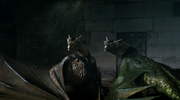
Viserion and Rhaegal imprisoned underneath the pyramid by Daenerys.
During her journey to Meereen, Daenerys's dragons have grown larger than they were before, feasting on a dead sheep. While scuffling over the carcass, Daenerys attempted to calm Drogon down, but the black dragon snapped at his mother due to his state in a feeding frenzy. Jorah then reminded Daenerys that dragons can never be tamed, not even by their own mother.[17]
After Daenerys claimed Meereen as its queen, Drogon continues to hunt for their food independently, burning and killing livestock of farmers that live around the Meereenese region.[18] Seeing that her children have grown wild and reckless, Daenerys decided to lock two of her three dragons, Viserion and Rhaegal, within the Great Pyramid, while the third and largest one, Drogon, was nowhere to be found.[19]
Season 5
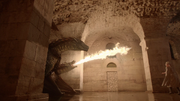
Rhaegal and Viserion defying their mother's presence.
Daenerys visits Rhaegal and Viserion after not seeing them for weeks. She soon sees they have grown larger and more aggressive than they were before. Realizing that her own children have turned against her, Daenerys has no choice but to keep her distance from them.[20] When Ser Barristan Selmy was murdered by the Sons of the Harpy, Daenerys feed one of the Great Masters to her dragons to make an example of what happens when someone defies her rule.[21]
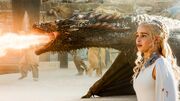
Drogon defending Daenerys from the Sons of the Harpy.
When the Sons of the Harpy attempted to assassinate Daenerys during the Great Games at the Daznak's Pit, Drogon flew in to protect his mother. Despite being injured, the black dragon managed to kill many Sons of the Harpy by tearing some with his teeth, crushing others under his feet and burning the rest with his flames. Daenerys then mounts him, speaks a single word to him "valahd" and he takes flight, making Daenerys the first dragonrider in over a century.[22]
Season 6
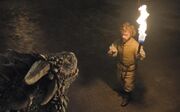
Tyrion faces the two dragons.
At the Great Pyramid in Meereen, Tyrion, Varys, Grey Worm and Missandei discuss the two remaining dragons locked beneath their feet. Grey Worm reports the dragons aren't eating, Tyrion proclaims it's because Dragons don't do well in captivity. He talks of their intelligence and how the Targaryens raised and locked up their dragons, leading to their extinction. He and Varys visit the dragons, claiming he's a friend of their mother, and releases them from their collars.[23]
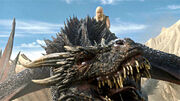
Drogon and Dany are reunited.
When the Red Priestess Kinvara comes to Meereen from Volantis, she notes to Tyrion and Varys that Daenerys's dragons are gifts from the Lord of Light, and they can burn the sins for those who have lack of faith in the Targaryen queen.[24]
While Daenerys's khalasar are riding to Meereen, she reunites with Drogon, who has grown about double in size.[25] She rode on his back to further demonstrate her leadership strength to the Dothraki. Afterward, Drogon flies Daenerys back to Meereen, which is being attacked by the Masters.[26]
When Daenerys refuses to surrender Meereen to the Masters, Drogon lands right by her side before allowing her to ride on his back. After the pair take flight, Rhaegal and Viserion break out of the Great Pyramid to join their mother and brother in burning a few of the Masters' ships with dragon fire.[27]
After the Second Siege of Meereen was won and the war over the Liberation of Slaver's Bay ended, the three Dragons fly west alongside Daenerys's newly acquired armada towards Westeros.[28]
Season 7
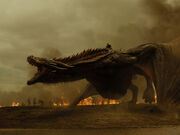
Drogon fully grown in Season 7.
Drogon, Rhaegal and Viserion fly ahead of their mother as she lands on Dragonstone. They investigate the island as Daenerys enters and secures the castle.[29]
After meeting with the lords of Westeros, Queen Cersei ventures into the vaults with Qyburn to see his "solution" for dealing with Daenerys's dragons. They pass several smaller dragon skulls before reaching the largest skull in the vaults, that of Balerion the Black Dread (King Aegon the Conqueror's dragon). Qyburn directs Cersei to a ballista (named a "scorpion") and reassures her that they can hurt dragons having heard about the spears that pierced Drogon's hide in Meereen. Cersei tests the ballista on the skull of Balerion and is pleased when the bolt pierces the massive, hard skull.[30]
For the first time, Daenerys rides the full-grown Drogon into battle at the Battle of the Goldroad. Also, Qyburn's scorpion is used for the first time, by Bronn, and is proven to pierce the hide of a dragon. However, Bronn only manages to shoot Drogon's shoulder, and doesn't do enough significant damage to mortally wound him.[31]
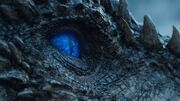
A dragon (Viserion) as a wight.
The dragons accompany Daenerys as they attempt to rescue Jon Snow and his group from the White Walkers and the army of the dead at the Wight Hunt beyond the Wall. Rhaegal and Viserion destroy hundreds of wights while Jorah, Tormund, Sandor Clegane, and Beric Dondarrion mount Drogon with Daenerys. However, not long after Daenerys's and Drogon's arrival, the Night King is given an ice spear by one of his Walker lieutenants. The Night King hurls it at Viserion, piercing straight through his neck in a fiery and bloody blast, fatally wounding him. The helpless dragon shrieks in agony as he drops like a stone, crashing through the frozen lake and sinking beneath the surface.
Later, the White Walkers have their wights haul Viserion's body out of the frozen lake, after which the Night King reanimates the corpse of the fallen dragon.[32] With Viserion as his mount, the Night King leads his army to Eastwatch-by-the-Sea and breaches the wall by having Viserion destroy a large section of it with fire, allowing his army to pass into the Seven Kingdoms.[33]
Season 8
Drogon and Rhaegal accompany their mother on their journey to Winterfell. Their presence both awe and terrify the Northmen. The two dragons don't really like the North and have not been eating a lot since their arrival. Rhaegal allows Jon to ride him as they fly together alongside Daenerys and Drogon.[34]
When the army of the dead arrives at Winterfell, Jon and Daenerys fly the dragons and order them to burn as many wights as possible in the Battle of Winterfell. They then give chase before battling the Night King and the undead Viserion. Both dragons sustain injuries throughout the battle, but they manage to survive.[35]
With the Night King and his army destroyed, the dragons fly back to Dragonstone as Daenerys resume her campaign to take the Iron Throne. Upon arriving on the island, Euron and his Iron Fleet ambush them with scorpion bolts, hitting Rhaegal three times before killing him. This leaves Drogon as the only known living dragon in the world.[36]
Daenerys utilizes Drogon effectively in the Battle of King's Landing, destroying the Golden Company, Euron's Iron Fleet, and the city gates. This induces King's Landing to surrender, allowing Daenerys to win her war. However, she proceeds to burn the city and its populace from atop of Drogon, turning King's Landing into a massive inferno.[37] After Jon reluctantly assassinates Daenerys to stop her destruction, Drogon finds Jon weeping while holding Daenerys's body. When Drogon realizes Daenerys is dead, he bellows in grief and rage and faces Jon. Jon prepares to die by Drogon's flames but instead, Drogon proceeds to burn the Iron Throne until it is nothing but a puddle of molten slag. When he is finished, Drogon picks up Daenerys's body in his talons before flying off across the Narrow Sea. Later in the episode, when Drogon's whereabouts are questioned, a newly elected King Bran Stark says that he will try to find Drogon. [38]
Known dragons
Daenerys Targaryen's dragons
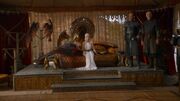
Daenerys and her Dragons.
- Drogon, named after Khal Drogo, black with red markings. Larger and more aggressive than his siblings, he is also the personal mount of Daenerys Targaryen. Also known as the winged shadow by common folk when Daenerys resided in Meereen. Went missing following the Assassination of Daenerys Targaryen. He is the last known dragon left in existence.
- {Rhaegal}, named after Rhaegar Targaryen, green with bronze markings. Daenerys allowed Jon Snow to mount him. Killed by Euron Greyjoy after being shot multiple times with a scorpion in the Battle at Dragonstone.
- {Viserion}, named after Viserys Targaryen, creamy white, with gold markings. Killed by the Night King after being pierced in the neck by an ice spear and then reanimated as his Wight mount. He was later destroyed by Arya Stark during the Battle of Winterfell after her killing of his dragonrider - severing the magical connection between them.
Known historical dragons
- This particular section contains MAJOR spoilers for House of the Dragon. Anyone wishing to avoid spoilers for the upcoming prequel series should not click [Expand].
Aegon the Conqueror's dragons
- Balerion, the dragon of Aegon the Conqueror and later Maegor the Cruel and Viserys I. Called the Black Dread, he was the largest of the known dragons and the only one who died peacefully when he was over 200 years old. Allegedly, the Iron Throne was forged in his breath. His skull is stored in the Red Keep.
- Vhagar, the dragon of Aegon I's sister-wife Visenya and later Aemond One-Eye. She was killed by another dragon, Caraxes, in the Battle Above the Gods Eye. Her skull is stored in the Red Keep.
- Meraxes, the dragon of Aegon I's sister-wife Rhaenys. She was killed by a scorpion bolt during the First Dornish War. Her skull is stored in the Red Keep.
Other dragons
- Sunfyre, Aegon II Targaryen's personal mount. He died from wounds sustained during the Dance of the Dragons.
- Syrax, Rhaenyra Targaryen's personal mount. She was killed in the Storming of the Dragonpit.
- Caraxes, Daemon Targaryen's personal mount. He was killed by Vhagar in the Battle Above the Gods Eye.
- Meleys, Rhaenys Velaryon's personal mount. She was killed by Vhagar and Sunfyre in the Siege of Rook's Rest.
- Vermax, Jacaerys Velaryon's personal mount. He was killed by archers in the Battle of the Gullet.
- Arrax, Lucerys Velaryon's personal mount. He was killed by Vhagar in the Dance Over Storm's End.
- Stormcloud, Aegon III Targaryen's personal mount. He died from wounds sustained during the Dance of the Dragons.
- Sheepstealer, Nettles's personal mount. He disappeared during the Dance of the Dragons.
- Seasmoke, Laenor Velaryon's personal mount. Later ridden by Addam of Hull. He was killed by Vermithor in the Second Battle of Tumbleton.
- Vermithor, Jaehaerys I Targaryen's personal mount. Later ridden by Hugh Hammer. He was killed by Seasmoke in the Second Battle of Tumbleton.
- Silverwing, Alysanne Targaryen's personal mount. Later ridden by Ulf the White. Became wild after Vermithor died.
- Quicksilver, Aegon Targaryen's personal mount. He was killed by Balerion in the Battle Beneath the Gods Eye.
- Shrykos, a dragon who lived during the Dance of the Dragons and was killed in the Storming of the Dragonpit.
- Morghul, a dragon who lived during the Dance of the Dragons and was killed in the Storming of the Dragonpit.
- Tyraxes, a dragon who lived during the Dance of the Dragons and was killed in the Storming of the Dragonpit.
- Dreamfyre, a dragon who lived during the Dance of the Dragons and was killed in the Storming of the Dragonpit.
- The last dragon - a stunted, sickly, inbred creature not much bigger than a cat, which died young.[39]
In Season 1's "Cripples, Bastards, and Broken Things", Viserys Targaryen lists off the names of several dragons whose skulls he says he saw stored in the Red Keep. This list is not from the books, none of them were ever mentioned again, and several of the names were inside jokes from the writers. The Targaryens did collect skulls of dragons that were in some cases thousands of years old, not ones that they possessed since they came to Westeros, so it's possible that these existed at some point or another in Valyria's five thousand year history. His list included Vermithrax (an inside joke referring to the dragon in the film Dragonslayer), Ghiscar, Valryon, Essovius, and Archonei.
Some other mythical creatures, whose existence is unproven, have "dragon" in their name but are unrelated to real dragons - such as Sea dragons and Ice dragons.
Gallery

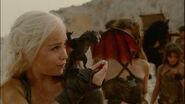
Drogon refuses food.
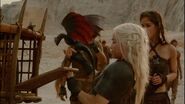
Drogon being put in his cage.

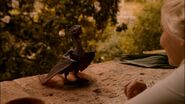
Drogon eating.
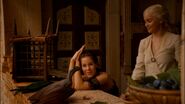


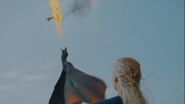
Drogon cooks a fish with dragon flame.
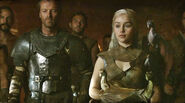
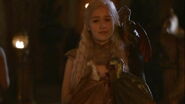
Daenerys and her dragons.
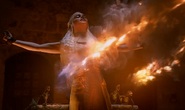
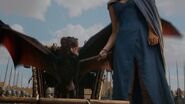
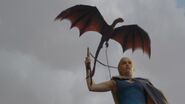
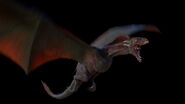
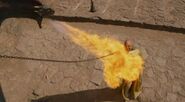
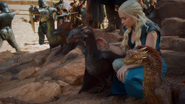
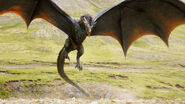
Drogon in Season 4
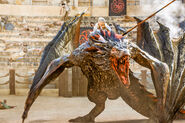
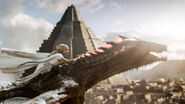
Dany's first time riding Drogon in Meereen, Season 6.
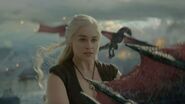
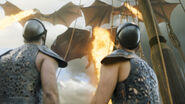
Daenerys's dragons setting a ship on fire

Drogon in Season 7
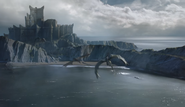
The dragons flying above Dragonstone
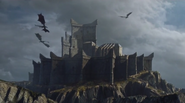
The dragons flying above Dragonstone
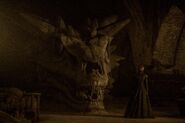
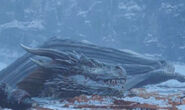
Viserion is slain by the Night King.
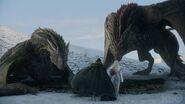
Rhaegal and Drogon
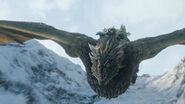
Jon riding Rhaegal
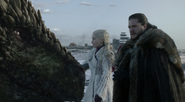
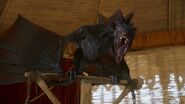
Drogon aggressively hisses at a Wise Master envoy from Yunkai.
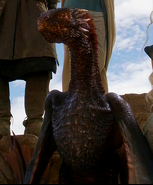
A growing Drogon awaits his mother's instructions.

Rhaegal, Drogon and Viserion at Yunkai.
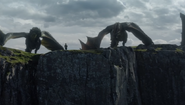
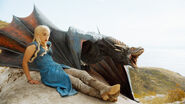
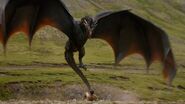
Drogon, now a massive adolescent, towers over a peasant.
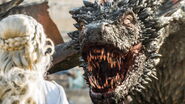
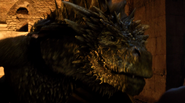
Rhaegal Season 5
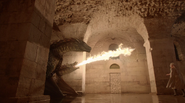
Rhaegal Season 5
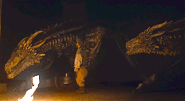
Season 5
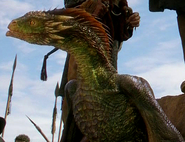
Rhaegal
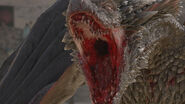
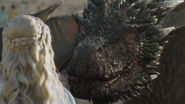
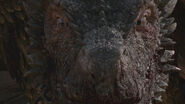
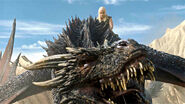
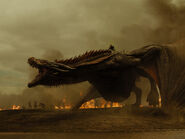
First look of Drogon in Season 7 Promo
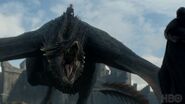
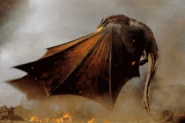
Drogon burning the loot train in Season 7.
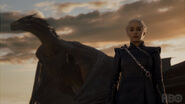
Drogon and Dany after the loot train attack, Season 7.
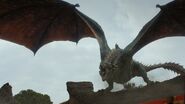
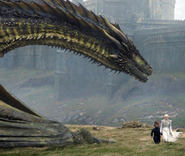
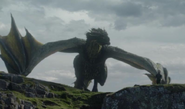
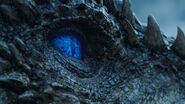
A dragon (Viserion) as a wight.
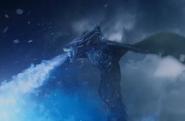
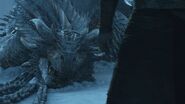

Rhaegal

Season 8
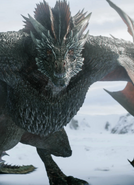
Season 8
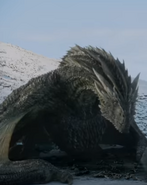
Rhaegal, Season 8
Quotes about dragons
Behind the scenes
The dragons in the TV series are CGI creations, though in Season 2 - when they were about the size of small cats - the actors did use prop-dragon puppets on-set, to make sure that their eye-lines matched.
Supervising sound editor Tim Kimmel explained in a Season 4 interview what went into creating the dragon scream sound effects and other vocalizations: "Each dragon has multiple animals stacked and put together to create it...[in Season 3] we used the sound of two tortoises mating. There are various birds that get used in there. We sneak some other things in there—last season we had some weird dolphin sounds. I believe there's a pissed-off seal in there somewhere, during some of the angry spots. We sometimes use lions for the growlier stuff."[40]

The real-life prop dragon eggs. (One was given to George R.R. Martin as a wedding gift.)
To create the noise of dragon claws clacking against hard surfaces as they move around, the sound effects team used a combination of beef-rib bones, and also press-on nails hot-glued to gardening gloves. That way, drumming the fingers of the glove against a hard surface sounds more realistic, like a dragon's individual claws hitting a surface.[41]
In Season 5, Drogon is about 40 feet long from snout to tail-tip, and 20 percent bigger than the other two dragons (making them around 32 feet long). In Season 5, several dragon traits were copied from different real-life animals: Komodo dragons, iguanas, horned lizards, and crocodiles. The dragons' physical motions were derived from eagles and bats while, for their takeoff into flight, pelicans were used as a reference.[42] Joe Bauer stated that in Season 6, the dragons will double in size yet again - which would make Drogon roughly 80 feet long, and the other two around 64 feet long.[43]
In Season 5, to give the actors a better prop to react to, instead of just dangling a tennis ball and pretending it was breathing fire, the special effects team took the extra step of custom-building a fire-breathing crane. They began with a Technodolly, a motion-controlled crane with a 15-foot high arm that moves in different directions while its base rolls along a track, with a telescopic arm that usually holds a camera. The crew then took the camera out, and in its place mounted a flamethrower that could shoot as far as fifty feet. The crane was then programmed with Drogon's movements, so it could repeat the same sequence over and over again for multiple takes of the same shot. Thus the stunt team, actors, and directors always knew exactly where the dragon and its fire was supposed to be. After filming finished, digital artists then added Drogon's body around the real flames in the shot. A second method they used in Season 5 was the "SimulCam" system: a basic animation of the dragon would be saved on the camera monitor and imposed over what it was pointed at, so the cameramen and directors could always see where a dragon was supposed to be moving in any given shot.[44]
The design and look of the dragons was motivated by the dragons in the SF movie Reign of Fire (2002).[45]
In the books
Biology
In the A Song of Ice and Fire novels, dragons are described as four-limbed creatures, with two legs and two wing-arms. In European tradition, this creature was more often called a wyvern, and "dragons" were distinguished as six-limbed creatures, with four regular legs and a pair of wings sprouting out of their back. George R.R. Martin relied on both science and folklore when constructing his dragons, and as he and other Fantasy authors have pointed out, in terms of real-life physics, it would be far more difficult for a six-limbed dragon to actually fly than a four-limbed dragon. Also, since all known terrestrial vertebrates (i.e. animals with backbones) have only four limbs, it makes more evolutionary sense to have the dragon's front limbs modified into wings - as with birds, bats and prehistoric pterosaurs - instead of evolving an entirely new set of limbs from nowhere.
In the books, the bones of dragons are black due to their high iron content. In the TV series, the skull Arya Stark sees beneath the Red Keep is shown to be white, through the dragonbone handle on her dagger is black. Dragon bone is especially favored for making bows, as it is stronger and more flexible than wood, making the arrows fly much farther. Dragon bone is also fireproof, giving it another advantage over wooden bows.
Dragons, like certain species of amphibians and fish, have no fixed biological sex; they can shift between male and female to meet the reproductive needs of the species. For example, only the five dragons possessed by House Targaryen survived the Doom of Valyria: if they were all originally female, some would have shifted into males so they could continue to breed with each other. While some real-life animals (mostly fish, certain frogs) are capable of shifting from one sex to the other, it is always a one-way and irreversible process. In contrast, dragons can switch sex back and forth over the course of their lives ("as mutable as flame"). Dragons in "male" or "female" state are visually indistinguishable, apparently possessing no external sex organs. The knowledge that dragons can shift sex was lost after the Doom of Valyria, however: during the first half of the Targaryen dynasty's rule over Westeros while they still had dragons, people apparently just assumed a dragon was male unless it was observed laying eggs, after which they assumed it was always female. In Fire & Blood, Archmaester Glydayn dismisses the possibility that Vermax secretly laid a clutch of eggs at Winterfell, simply because it was never observed laying eggs before or since, so it was assumed that Vermax was always male. Dragons which frequently laid eggs were assumed to be "she-dragons" and sometimes called "queens" ("Meleys the Red Queen" and "Tessarion the Blue Queen"). Dragons considered female / confirmed egg-layers included Vhagar, Dreamfyre, Silverwing, Meleys, Syrax, and Tessarion.
Growth
According to Valyrian records, dragons hatch small - about the size of an average cat – growing larger as they age and as their appetites expand; physically, a dragon never stops growing as long as it remains fed, and it was said that Balerion the Black Dread, Aegon the Conqueror's dragon, was so huge by the time he died that he could swallow an aurochs whole. Dragons can have extremely long lifespans, but Barristan Selmy states that it isn't known for certain how long the average dragon lives before dying of natural causes. This is largely because dragons were originally trained and used as weapons of war, and thus usually died of violent unnatural causes. Balerion may well have been the only Targaryen dragon that grew to healthy adulthood and simply died from old age.
Feeding
Something of a joke throughout the novels is that dragons seem to prefer sheep as their main food (though they will eat any animal smaller than themselves if they are hungry enough) - apparently a reference to the myth of St. George and the Dragon. The ancient Valyrians who first trained and rode dragons were shepherds, and as such fed sheep to their mounts. During the great Targaryen civil war known as the Dance of the Dragons, one wild dragon had such a fondness for sheep that the small-folk whose livestock he stole named him "Sheepstealer". A girl named Nettles ultimately managed to bond with Sheep-stealer when she realized his preference, and brought him a new sheep every day until he grew accustomed to her presence. At Meereen, Daenerys's dragons often attack the flocks of local shepherds: In an effort placate Drogon after he breaks loose, various animals are assembled in local fighting pits to try to keep him well-fed enough so that he won't attack any more humans: one pen is filled with bulls, and another filled with a wide variety of exotic animals from across the world (lions, tigers, bears, etc.) which were meant to fight in the pits - but even with this wide selection of potential meals, Drogon still prefers to go after the pen filled with sheep. This may be a reference to the real-life myth of St. George and the dragon: villages being attacked by a dragon placated the beast for a time by leaving it fresh sheep as tribute (though eventually they ran out of sheep, and had to start sacrificing young maidens). This preference for sheep wasn't an absolute rule for every dragon: during the Dance, a dragon called Grey Ghost was said to have a taste for fish, and fishermen often saw him in the distance snatching prey from the waters. Larger dragons were known to swallow oxen and horses whole, and in the aftermath of battles to feast on fallen men and their mounts alike.
Vulnerabilities
Aside from their ability to breathe fire, dragons were ferociously strong. They were, however, vulnerable to sustained arrow fire from the ground, to poison, and to attacks from other dragons. According to Tyrion – who has read books on the subject – a dragon's eyes are its only real weak spot (not the throat or underbelly as old wives' tales claim), and that the only certain way to kill a dragon is to pierce its eyes deep enough to puncture the brain behind them: Meraxes, Rhaenys Targaryen's dragon, was killed in precisely this manner during a conflict with the Dornish. Only other dragons are strong enough to pierce a dragon's scales, with tooth and claw. Some of the younger dragons that died in the Dance, who didn't have thick scales yet, were killed by piercing their hides, but this was still very difficult.
The bottom line is that while dragons were extremely powerful, they were not outright invincible. Also, given their rarity and the large effort/expense in training them, they were not simply deployed in battle on a whim: Even Aegon the Conqueror was reluctant to commit all of his dragons to a single battle, for fear that they might be overwhelmed by greater numbers. Thus, Aegon took a calculated risk when he unleashed all three of his dragons for the first and only time at the Field of Fire, the battle which secured his conquest.
Intelligence
Dragons are very intelligent creatures - at times seeming to approach human levels of intelligence and emotion - but they never specifically display it: Dragons can't physically talk, and although they can understand voice commands from humans, this is no more than what a dog or a horse can do. Rather, dragons appear to have some sort of higher, unnatural level of intelligence; they seem to be more in tune with the workings of the universe (i.e. "magic" or "fate" or "nature") than humans are, and possess a sense of mental awareness that humans do not. Somehow, they are often able to sense when the human rider they are bonded with needs them - something hinted at in the Season 5 episode "The Dance of Dragons", when Drogon arrives seemingly out of nowhere to rescue Daenerys.
Training
While the specific methods used in training them are not widely known at the time of the novels (such information was nearly all lost in the Doom of Valyria), it has long been believed that only those who possess Valyrian blood (such as the Targaryens) can bond with and ride dragons. This may be for the simple reason that the Valyrians were the first to accomplish this feat, and dragons do seem to be inherently friendlier around people with at least some Valyrian blood. This may also be a reason for the dragonlords' infamous tradition of incestuous marriage; if their Valyrian blood became too diluted by marrying and reproducing with outsiders, their control over their dragons would become less stable. During the Dance of the Dragons, for example, Rhaenyra Targaryen had many dragons at her disposal but not enough allies able to ride them. Therefore, she sought out any surviving Targaryen bastards in the hope that their partial Valyrian descent would enable them to bond with the dragons (which some were able to do, but others were not).
The dragonlords of Old Valyria were known to control their mounts with whips, binding spells, and sorcerous horns. Euron Greyjoy claims to have such a horn, which he calls "Dragonbinder". He has given it to his brother Victarion for "binding" Daenerys's dragons, but it has not been put to test yet.
History
The Valyrians first discovered dragons nesting in the warmth of the Fourteen Fires – a chain of volcanoes on the Valyrian Peninsula – but it is not known for certain where dragons originated. The World of Ice & Fire sourcebook mentions that cultures throughout the known world each have their own legends regarding the origins of dragons. Also, ancient dragon bones have been found in such far-flung places as the island of Ib and on the continent of Sothoryos, where the Valyrians never established a significant foothold. Other than Valyria itself, the only plausible origin site for dragons within the known world is Asshai and the surrounding Shadow Lands; dragon bones and petrified dragon eggs are frequently found there, and the inhabitants claim that dragons existed in the region since before Valyria was founded (Asshai also claims to be the oldest city in the world, but no one can confirm or deny this). The question is further complicated by the fact that multiple "species" of dragons exist - or are said to exist - in different regions of the known world, and there is no evidence to confirm or deny that these species are in any way related to each other: large flying reptiles known as wyverns are known to exist on Sothoryos; myths and legends speak of ice dragons in far northerly reaches of the Shivering Sea; and the deepest regions of the Sunset Sea are said to be home to enormous sea dragons, such as Nagga in the stories of the ironborn. There is also the possibility that dragons did not originate in any currently explored region of the known world. Whatever the case, the Valyrians were the first people whose interaction with dragons can be historically confirmed, and they succeeded in harnessing the power of dragons as no one else had or ever did. During the conquest of the Rhoynar, the Valyrian Freehold commanded at least 300 dragons and their riders. It is not known how many dragons the Freehold possessed in its final years, but the only ones known to have survived the Doom of Valyria were those belonging to House Targaryen, who later used them to conquer the Seven Kingdoms.
The Targaryens kept dragons in Westeros for approximately 150 years, roughly half of their dynasty. After the dragons died, their preserved skulls were put on display in the Red Keep. Tyrion states that there are nineteen skulls in all, which for a time led to the misconception that there were only ever nineteen Targaryen dragons - however, Tyrion also says that the oldest skull is three thousand years old: The oldest Targaryen dragon was Balerion, who hatched over four hundred years ago and died after living for about two centuries. Thus the nineteen skulls were never an accurate count of all the Targaryen dragons, and the Targaryens apparently acquired several skulls from Essos. According to information from Martin's other writings, there were at least 24 Targaryen dragons throughout the dynasty's history (and possibly a few more). Twenty dragons were alive during the Dance of the Dragons (of which three were hatchlings too small to ride), and several hatchlings died young in the generations prior to the Dance, never having riders.
Most of the Targaryen dragons were killed in the Dance, which occurred 130 years after the Targaryen Conquest (150 years before Robert's Rebellion). Martin's short story The Princess and the Queen confirmed that twenty dragons were alive at the beginning of the Dance: Rhaenyra's faction based at Dragonstone had fourteen dragons (of which one was a hatchling), while Aegon II's faction at King's Landing had only six (of which two were hatchlings, but one of the others was the massive Vhagar). Only three dragons - Silverwing, the Cannibal, and Sheepstealer - survived the Dance, all of them left riderless, though another one (Morning) hatched late in the war. Two of these four, Cannibal and Sheepstealer, mysteriously vanished soon after the war, and their fate is unknown.
Of Aegon's original three dragons, Meraxes was killed in Dorne during Aegon's invasion, Balerion died in the peaceful reign of King Jaehaerys I, just under a hundred years after the Conquest, and Vhagar was killed in the Dance of Dragons. The few surviving dragons after the Dance were weak and sickly, with the last dragon (a stunted creature not much bigger than a large dog) dying during the reign of Aegon III Targaryen, the Dragonbane, only 22 years after the end of the Dance. The last dragons left behind several eggs, which never hatched. These eggs were later destroyed or lost to the vagaries of history. As a result, dragons are now considered to be extinct.
See also
References
- ↑ "Winter Is Coming"
- ↑ "The Kingsroad"
- ↑ "The Wolf and the Lion"
- ↑ "A Golden Crown"
- ↑ "Fire and Blood"
- ↑ "The North Remembers"
- ↑ "The Ghost of Harrenhal"
- ↑ "The Prince of Winterfell"
- ↑ "The Old Gods and the New"
- ↑ "A Man Without Honor"
- ↑ "Valar Morghulis"
- ↑ "Walk of Punishment"
- ↑ "And Now His Watch Is Ended"
- ↑ "The Bear and the Maiden Fair"
- ↑ "The Rains of Castamere"
- ↑ "Mhysa"
- ↑ "Two Swords"
- ↑ "The Laws of Gods and Men"
- ↑ "The Children"
- ↑ "The Wars to Come"
- ↑ "Kill the Boy"
- ↑ "Dance of the Dragons
- ↑ "Home"
- ↑ "The Door"
- ↑ "Blood of My Blood"
- ↑ "No One"
- ↑ "Battle of the Bastards"
- ↑ "The Winds of Winter"
- ↑ "Dragonstone"
- ↑ "Stormborn"
- ↑ "The Spoils of War"
- ↑ "Beyond the Wall"
- ↑ "The Dragon and the Wolf"
- ↑ "Winterfell"
- ↑ "The Long Night"
- ↑ "The Last of the Starks"
- ↑ "The Bells"
- ↑ "The Iron Throne"
- ↑ "Cripples, Bastards, and Broken Things"
- ↑ [1]
- ↑ [2]
- ↑ TV Guide magazine, April 9-16, 2015
- ↑ [3]
- ↑ TV Guide magazine, April 9-16, 2015
- ↑ https://www.youtube.com/watch?v=HGVwMmOZ4YY (vague reference; timestamp needed)
| ||||||||||||||
| ||||||||||||||
macdougallnoth1952.blogspot.com
Source: https://gameofthrones.fandom.com/wiki/Dragon